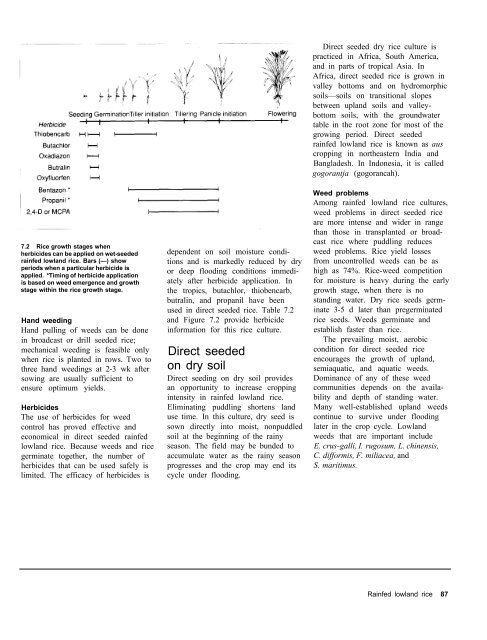A handbbok on Weed Control in Rice.pdf
A handbbok on Weed Control in Rice.pdf
A handbbok on Weed Control in Rice.pdf
Create successful ePaper yourself
Turn your PDF publications into a flip-book with our unique Google optimized e-Paper software.
7.2 <strong>Rice</strong> growth stages when<br />
herbicides can be applied <strong>on</strong> wet-seeded<br />
ra<strong>in</strong>fed lowland rice. Bars (—) show<br />
periods when a particular herbicide is<br />
applied. *Tim<strong>in</strong>g of herbicide applicati<strong>on</strong><br />
is based <strong>on</strong> weed emergence and growth<br />
stage with<strong>in</strong> the rice growth stage.<br />
Hand weed<strong>in</strong>g<br />
Hand pull<strong>in</strong>g of weeds can be d<strong>on</strong>e<br />
<strong>in</strong> broadcast or drill seeded rice;<br />
mechanical weed<strong>in</strong>g is feasible <strong>on</strong>ly<br />
when rice is planted <strong>in</strong> rows. Two to<br />
three hand weed<strong>in</strong>gs at 2-3 wk after<br />
sow<strong>in</strong>g are usually sufficient to<br />
ensure optimum yields.<br />
Herbicides<br />
The use of herbicides for weed<br />
c<strong>on</strong>trol has proved effective and<br />
ec<strong>on</strong>omical <strong>in</strong> direct seeded ra<strong>in</strong>fed<br />
lowland rice. Because weeds and rice<br />
germ<strong>in</strong>ate together, the number of<br />
herbicides that can be used safely is<br />
limited. The efficacy of herbicides is<br />
dependent <strong>on</strong> soil moisture c<strong>on</strong>di-<br />
ti<strong>on</strong>s and is markedly reduced by dry<br />
or deep flood<strong>in</strong>g c<strong>on</strong>diti<strong>on</strong>s immedi-<br />
ately after herbicide applicati<strong>on</strong>. In<br />
the tropics, butachlor, thiobencarb,<br />
butral<strong>in</strong>, and propanil have been<br />
used <strong>in</strong> direct seeded rice. Table 7.2<br />
and Figure 7.2 provide herbicide<br />
<strong>in</strong>formati<strong>on</strong> for this rice culture.<br />
Direct seeded<br />
<strong>on</strong> dry soil<br />
Direct seed<strong>in</strong>g <strong>on</strong> dry soil provides<br />
an opportunity to <strong>in</strong>crease cropp<strong>in</strong>g<br />
<strong>in</strong>tensity <strong>in</strong> ra<strong>in</strong>fed lowland rice.<br />
Elim<strong>in</strong>at<strong>in</strong>g puddl<strong>in</strong>g shortens land<br />
use time. In this culture, dry seed is<br />
sown directly <strong>in</strong>to moist, n<strong>on</strong>puddled<br />
soil at the beg<strong>in</strong>n<strong>in</strong>g of the ra<strong>in</strong>y<br />
seas<strong>on</strong>. The field may be bunded to<br />
accumulate water as the ra<strong>in</strong>y seas<strong>on</strong><br />
progresses and the crop may end its<br />
cycle under flood<strong>in</strong>g.<br />
Direct seeded dry rice culture is<br />
practiced <strong>in</strong> Africa, South America,<br />
and <strong>in</strong> parts of tropical Asia. In<br />
Africa, direct seeded rice is grown <strong>in</strong><br />
valley bottoms and <strong>on</strong> hydromorphic<br />
soils—soils <strong>on</strong> transiti<strong>on</strong>al slopes<br />
between upland soils and valley-<br />
bottom soils, with the groundwater<br />
table <strong>in</strong> the root z<strong>on</strong>e for most of the<br />
grow<strong>in</strong>g period. Direct seeded<br />
ra<strong>in</strong>fed lowland rice is known as aus<br />
cropp<strong>in</strong>g <strong>in</strong> northeastern India and<br />
Bangladesh. In Ind<strong>on</strong>esia, it is called<br />
gogorantja (gogorancah).<br />
<strong>Weed</strong> problems<br />
Am<strong>on</strong>g ra<strong>in</strong>fed lowland rice cultures,<br />
weed problems <strong>in</strong> direct seeded rice<br />
are more <strong>in</strong>tense and wider <strong>in</strong> range<br />
than those <strong>in</strong> transplanted or broad-<br />
cast rice where puddl<strong>in</strong>g reduces<br />
weed problems. <strong>Rice</strong> yield losses<br />
from unc<strong>on</strong>trolled weeds can be as<br />
high as 74%. <strong>Rice</strong>-weed competiti<strong>on</strong><br />
for moisture is heavy dur<strong>in</strong>g the early<br />
growth stage, when there is no<br />
stand<strong>in</strong>g water. Dry rice seeds germ-<br />
<strong>in</strong>ate 3-5 d later than pregerm<strong>in</strong>ated<br />
rice seeds. <strong>Weed</strong>s germ<strong>in</strong>ate and<br />
establish faster than rice.<br />
The prevail<strong>in</strong>g moist, aerobic<br />
c<strong>on</strong>diti<strong>on</strong> for direct seeded rice<br />
encourages the growth of upland,<br />
semiaquatic, and aquatic weeds.<br />
Dom<strong>in</strong>ance of any of these weed<br />
communities depends <strong>on</strong> the availa-<br />
bility and depth of stand<strong>in</strong>g water.<br />
Many well-established upland weeds<br />
c<strong>on</strong>t<strong>in</strong>ue to survive under flood<strong>in</strong>g<br />
later <strong>in</strong> the crop cycle. Lowland<br />
weeds that are important <strong>in</strong>clude<br />
E. crus-galli, I. rugosum, L. ch<strong>in</strong>ensis,<br />
C. difformis, F. miliacea, and<br />
S. maritimus.<br />
Ra<strong>in</strong>fed lowland rice 87











